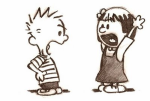 Welcome to the Two Writing Buddies dialogs, where we talk about our creative process and issues that arise in our writing.
Welcome to the Two Writing Buddies dialogs, where we talk about our creative process and issues that arise in our writing.
We’re experimenting with using an author quote as a jump-off point in our discussion on writing. This time it’s one by John Gardner on plot:
In nearly all good fiction, the basic—all but inescapable—plot form is this: A central character wants something, goes after it despite opposition (perhaps including his own doubts), and so arrives at a win, lose, or draw.
–John Gardner
Robine: The key element in this oversimplified plot description is opposition, that is, conflict. The problem in my novel Marshall’s Child, according to the instructor of a writing course I took recently, is that the conflict—Kat wants a baby but her husband Marshall does not—is not compelling enough. The instructor also felt that the action should more directly be focused on advancing the plot and should not be just a sequence of events.
So the question for you, Denise, is how strong does the conflict in a story have to be? How much does a story have to rely on plot, as described above by Gardner? And does conflict equal plot? Can you have a good story “whose strength,” as Gardner suggests elsewhere, “is language or structure or playfulness, and whose plot is weak and ailing?”
Continue reading



